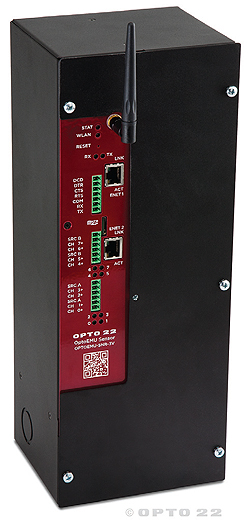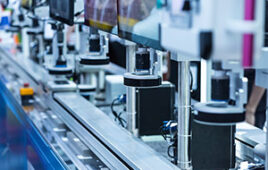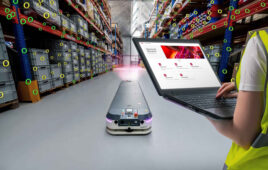By Selam Shimelash, Application Engineer, Opto 22
The premise is simple—to reduce energy costs, manage energy consumption. However, managing consumption requires that you monitor and understand your energy usage. Here are five tips that will help you get started:

Monitoring systems should connect to a range of power-related equipment, such as utility meters and load panels any manufacturing machines specific to your business, and so on. The data from these units should provide sufficiently high levels of granularity to generate detailed reports and observe changes in each asset’s individual power draw.
1. Get buy-in from the top.
It’s easy to switch to fluorescent light bulbs or raise the temperature on the A/C, but real energy management is going to require support from the top. How do you sell energy monitoring at the highest levels of your organization?
Presently, few organizations are set up to account for their energy usage. Power bills typically go straight to personnel in accounts payable, who don’t ask questions but simply cut checks. Even if managers look at a power bill, the bill shows no detail on when or where energy was used.
Increasingly, utility companies price energy based on the time of day it is used or penalize customers who exceed a maximum threshold during the billing period. They do offer incentives to customers who agree to reduce usage under certain conditions. These developments in pricing and demand-response offer savvy companies significant ways to improve their bottom line, just by paying closer attention to energy usage and costs.
Some larger businesses are creating new positions in their companies with titles like “energy manager” and “vice president of sustainability.” Individuals in these positions view energy not as a fixed cost, but as one that can be managed to the company’s benefit.
Though the return on investment will be evident later, investing in understanding your energy usage now is worthwhile.
2. Gather data first; then manage.
Once you’ve sold energy monitoring to your organization, it’s time to start gathering data—detailed, real-time data that you can see and analyze.
The data must be detailed enough and timely enough to see spikes in usage when an air-handling unit or compressor cycles on. These data should be visible to all key people in your organization who use energy, giving them not only the information, but also the motivation to reduce costs.
The key is to first fully understand what’s taking place. Only after you’ve aggregated and evaluated a volume of energy-related data should you begin investing in automation hardware and exercising new types of control over your processes, machines, and systems.

Pulse Energy’s Pulse and eSight is an example of a cloud-based application that graphically represents your energy data.
3. Choose the right hardware.
Monitoring energy usage in commercial buildings and industrial facilities is different from monitoring energy in your home. A “big picture” summary of overall energy consumption is a good start, but it won’t provide the details and granularity to identify which of your systems and machines are your biggest energy consumers, and which are costing you the most to operate. Choose industrial-grade energy monitoring hardware that will monitor, gather, and distribute energy data in real time.
On the other hand, you probably don’t need a large, complex, expensive building management system (BMS) or energy management system (EMS). You can start with a simple appliance as long as it meets certain requirements for connectivity with electrical equipment and (for the future) control systems.
Your monitoring system should be able to connect to a range of power-related equipment. This equipment includes utility meters and load panels, any manufacturing machines specific to your business, and common building management systems like lighting and HVAC chillers and compressors.
The data from these units should provide sufficiently high levels of granularity to generate detailed reports and observe changes in each asset’s individual power draw.
The monitoring hardware should also be web-capable (to enable monitoring and alarming over the internet) and easy to configure.
Energy monitoring is rarely the primary job of one individual. Most people looking to implement energy monitoring have little time for complicated installations or configuration. So, they need more of an “out-of-the-box” appliance that will allow them to understand their consumption quickly and not take them away from their primary tasks.
Keep in mind, though, that while simple to install and use, the monitoring hardware you choose should also be compatible with control and automation systems. Once you’re ready to manage energy as well as monitor it, the data from the monitoring system must be easily integrated with control systems.
4. Consider your software options.
Energy monitoring hardware is only half the battle. You need a software tool to aggregate your data so that they are easy to see, analyze, and use.
You have two options for energy monitoring software: cloud-based or local.
Cloud-based software is a service by an online company. Your energy monitoring hardware sends data directly to the company, and any authorized person in your company can see it over the Internet, from anywhere, using a computer or sometimes a cell phone or other mobile device.
Cloud-based applications can provide simple, graphical interfaces to your data. Some cloud-based applications are sophisticated tools that let you organize and present data in varied ways and that even help you analyze energy usage. Pulse Energy’s Pulse and eSight Energy’s eSight are examples.
Local software, in contrast, is installed on your own company server or individual computers. If your data are sensitive, you may prefer to keep this information in-house.
Local energy-monitoring software can be purchased online (for example, eSight has software you can purchase and install) or be designed as custom software by your own engineers or a system integrator.
Available software varies depending on the hardware you choose, so make sure the software and hardware you want to use work together.
5. Understand that monitoring is simply a means to an end.
Monitoring simply for the sake of monitoring is not the goal. Ultimately your goal is to reduce the cost of energy for your company. Energy monitoring gives you the information you need to associate operational conditions with energy consumption statistics, so decision makers in your plant or facility can enact effective energy management policies.
The bottom line is lower energy costs—and detailed energy monitoring is the first step to get you there.
Opto 22
www.optoemu.opto22.com
Filed Under: Factory automation, Green engineering • renewable energy • sustainability, Energy management + harvesting, SENSORS, TEST & MEASUREMENT





Tell Us What You Think!